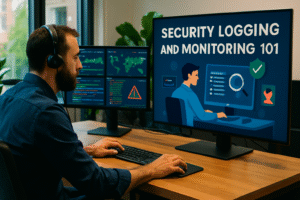
Top 5 cybersecurity skills to learn in 2025
In a world where digital transformation is accelerating across every sector, cybersecurity has become a defining concern. Organizations, governments, and individuals alike are re-evaluating how they safeguard their data, privacy, and operations. For those starting a career in technology, or considering a transition into cybersecurity, the landscape is both challenging and full of opportunity. Whether you are a student, a woman aspiring to break into tech, or a neurodivergent learner seeking your niche, understanding the most in-demand cybersecurity skills is an essential first step.
1. Network Security Fundamentals
Network security forms the foundation of any cybersecurity strategy. As organizations migrate to hybrid and cloud-based infrastructures, the complexity of protecting data in transit and at rest grows.
To excel in network security, beginners should gain proficiency in:
- Understanding TCP/IP, UDP, and common network protocols
- Configuring and managing firewalls, VPNs, and intrusion detection/prevention systems (IDS/IPS)
- Identifying common network attacks like man-in-the-middle, DNS spoofing, and ARP poisoning
- Monitoring network traffic and analyzing logs for suspicious activity
Mastering these basics is not just technical; it’s about developing a mindset that anticipates how networks can be exploited and how to build resilient architectures.
“Learning network security is like learning a new language. It’s not about memorizing every word, but understanding how the grammar fits together to convey meaning—and to spot when something doesn’t belong.”
For neurodivergent learners, network security offers clear frameworks and structured problem-solving—qualities that can play to their strengths.
2. Threat Intelligence & Incident Response
The ability to detect, analyze, and respond to cyber threats is a core competency for every cybersecurity professional. Threat intelligence involves gathering and interpreting information about potential and active threats, while incident response is the action plan for containing and mitigating those threats.
Key skills in this domain include:
- Recognizing indicators of compromise (IoCs) across endpoints and networks
- Using Security Information and Event Management (SIEM) systems like Splunk or Sentinel
- Understanding malware, phishing, and social engineering techniques
- Applying frameworks such as MITRE ATT&CK or NIST for incident response
- Communicating findings clearly to both technical and non-technical stakeholders
Empathy and communication are vital here. Incident response is not just a technical process; it’s also about managing stress, collaborating under pressure, and supporting affected users.
“Cybersecurity isn’t just about defense, but about resilience—helping organizations recover, learn, and adapt after an incident.”
Women entering cybersecurity often excel in this area, leveraging strong analytical and interpersonal skills to bridge gaps between teams and ensure effective responses.
Building Your Threat Intelligence Toolkit
For beginners, start by familiarizing yourself with open-source threat feeds, basic malware analysis, and simulated incident response exercises. Even a small home lab can provide invaluable hands-on experience.
3. Secure Coding and Application Security
As software becomes ever more central to business and daily life, vulnerabilities in code are prime targets for attackers. Secure coding means developing software that resists exploitation—an essential skill not just for developers, but for anyone involved in the technology lifecycle.
Areas to focus on include:
- Understanding the OWASP Top 10 vulnerabilities (such as SQL injection and cross-site scripting)
- Code review and static/dynamic application security testing
- Implementing authentication, authorization, and encryption best practices
- Working with DevSecOps tools to integrate security in continuous integration/continuous deployment (CI/CD) pipelines
Secure coding fosters creativity and precision. Neurodivergent learners, especially those who thrive on detail and pattern recognition, may find application security particularly rewarding.
“Security should be a conversation at every stage of software development, not a box to check after deployment.”
Breaking into Secure Coding
You don’t need to be a software engineer to contribute. Begin with code snippets, online challenges, or open-source projects focused on security. Collaboration is key—pair programming and code reviews help build both skills and confidence.
4. Cloud Security and Zero Trust Architecture
Cloud computing is no longer optional for most organizations; it’s the backbone of modern IT. With this shift comes new security challenges—and new opportunities for those who understand them.
Key competencies in cloud security include:
- Understanding shared responsibility models across AWS, Azure, and Google Cloud
- Implementing access controls, identity and access management (IAM), and encryption for data in the cloud
- Monitoring cloud environments for misconfigurations and vulnerabilities
- Designing Zero Trust architectures that treat every user and device as untrusted by default
The future of cybersecurity is cloud-native and identity-centric. This area is especially open to diverse learners and career-changers, as the demand for talent far outpaces supply.
“Zero Trust isn’t about paranoia; it’s about pragmatism. Assume breach, verify every access, and limit privileges to the minimum necessary.”
Learning Cloud Security as a Beginner
Many cloud providers offer free or low-cost training and sandbox accounts. Experiment with real-world scenarios—set up a simple cloud environment, configure IAM policies, and practice responding to simulated security events.
5. Cybersecurity Awareness & Human Factors
No matter how advanced the technology, humans remain the most critical component of cybersecurity. Social engineering attacks, phishing, and poor cyber hygiene are persistent threats that technology alone cannot solve.
Building skills around human factors involves:
- Designing and delivering effective security awareness training
- Understanding behavioral psychology and motivation
- Developing policies and procedures that support secure behavior, not just compliance
- Identifying and addressing accessibility and inclusion in security solutions
Empathy is a superpower. The most effective cybersecurity professionals understand how people think and behave, tailoring their approach to educate, empower, and protect diverse users.
“Cybersecurity is everyone’s job. The best solutions are those that make it easier for people to do the right thing, even when they’re busy or distracted.”
Empowering Neurodivergent and Underrepresented Learners
People with diverse cognitive styles often spot patterns or vulnerabilities others miss. Encouraging their participation in cybersecurity awareness initiatives leads to stronger, more creative defenses. Inclusion is not just a value—it’s a competitive advantage in the fight against cyber threats.
How to Start Learning These Skills
Embarking on a cybersecurity journey can feel overwhelming, but the field is rich with resources and welcoming communities. Here are a few actionable steps:
- Take advantage of free online courses and labs from platforms like Cyber Aces, TryHackMe, and Open Security Training
- Join local or online cybersecurity groups, such as Women in CyberSecurity (WiCyS) or Neurodiversity in Cyber
- Participate in Capture the Flag (CTF) competitions, which offer fun, practical challenges for all skill levels
- Volunteer for open-source security projects or awareness campaigns
- Seek out mentors and peer support—cybersecurity thrives on collaboration and shared learning
Remember: There is no single path into cybersecurity. Every background, every perspective, and every skill set can contribute to a safer digital world.
“The best cybersecurity teams are mosaics of experience, creativity, and resilience. There is a place for everyone—and that includes you.”
As we move toward 2025, the demand for cybersecurity professionals will only increase. By focusing on these five skills—network security, threat intelligence, secure coding, cloud security, and human factors—you are not just preparing for a job, but equipping yourself to make a meaningful impact. Whether you’re coding your first secure script, responding to your first incident, or teaching your colleagues about phishing, each step brings us closer to a safer, more inclusive digital future.


